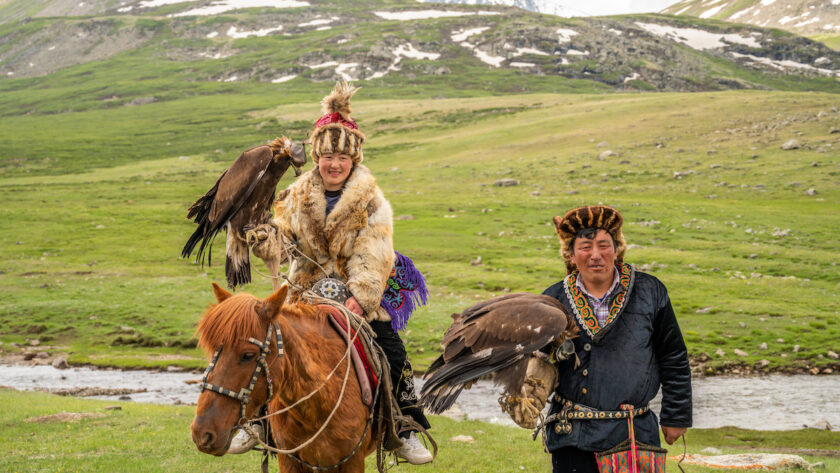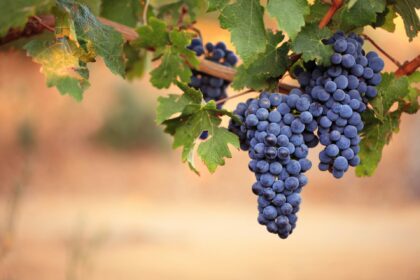By Jessie Festa. This story on the Mongolian Altai Mountains contains affiliate links to trusted partners.
The Altai Mountains in Mongolia are a truly magical place — beginning with the flight.
I love flying into mountain cities and seeing colorful Monopoly-sized buildings surrounded by jagged peaks. It provides a preview of what is to come — which is exactly what happens when I fly into Ulgii (Ölgii), Mongolia.

Situated in western Mongolia, Ulgii is the capital of the Bayan-Ölgii Province and the gateway to the stunning Altai Mountain region.
This area is also known for its unique cultural diversity, as it is home to the Kazakh community.
These people are descendants of Kazakhs who migrated to Mongolia in the late 19th and early 20th centuries, fleeing political unrest in Kazakhstan and seeking better grazing lands for their livestock.
Journeying Into The Altai Mountains Of Mongolia
It’s from here that we start our wild four-hour journey into the mountains. The destination: a ger homestay with a Kazakh family.
I’m with a group of women on a WHOA Travel trip done in partnership with Eternal Landscapes Mongolia, and it doesn’t take long until the scenery has everyone in my van in amazement.
Even from the highway, the colorful mountains create a rainbow of layers that seem to stretch on forever.


We stop for photos frequently, using yaks and wildflowers as the subjects for stunning mountain pictures.
After about an hour, we turn off the main highway onto a dirt road. This is when the scenery gets even better — and the drive gets even more adventurous.
Off-roading, traversing up and down rock piles, leaning into deep turns, and bouncing out of our seats are all part of the fun. I’m glad I skipped having a spa day earlier in the week, as I’m getting a “Mongolian massage” free of charge.
Luckily it’s a Land Rover, as at one point we cross a river so high and wide that water spills into the car. The group cheers as we make it to the other side without getting stuck. You’ll definitely want an experienced driver for this ride!
As we get deeper into the Altai region, the scenery truly looks like the Sound of Music, with rivers playing a soothing melody as they rush over rocks. The landscape is verdant green with lush valleys hugged by jagged peaks.
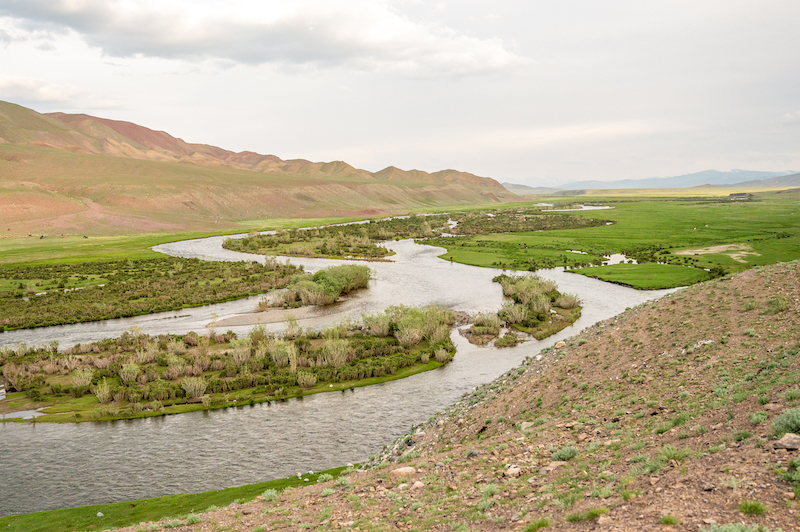
These mountains start out as green slopes and snow-capped peaks, though soon turn into an array of colors, with shades of red, orange, yellow, brown, green, and blue creating a stunning and surreal visual display.
We also pass Sari Kol (Lake Sari), one of Mongolia’s highest lakes at 2,080 meters (6,824 feet). Its crystal-clear waters reflect the surrounding landscapes for a stunning scene.
Finally, we see a sign that reads “I Love Altai,” with a small town just beyond it. Only 20 kilometers (12.5 miles) more to go.
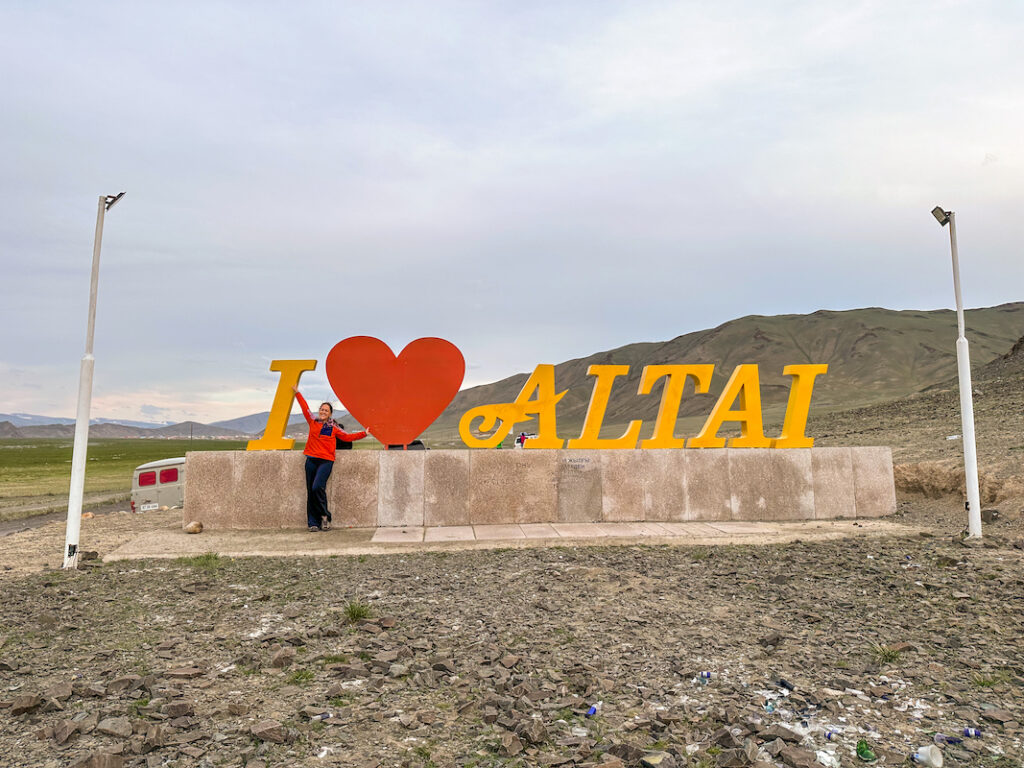
A Ger Homestay In The Altai Mountains
The sun has set by the time we reach the ger, and our hosts — husband and wife Asker and Ahgul — greet us excitedly, welcoming us with warm milk tea made by steeping tea leaves in water along with milk and salt.
In Mongolia, milk is a very important part of the culture, and when visiting a local home you’ll likely be offered some type of dairy drink.
While the recipe varies from place to place, it is a way to welcome you and show respect that also reflects their nomadic way of life, so be sure to accept the offering.

After our milk tea, we’re shown to our gers, which are traditional dwellings that look similar to yurts, though there are some regional and cultural variations in the terminology and design.
For example, Mongolian gers tend to have a slightly more conical shape, with a taller central crown and steeper walls.
My ger is covered in colorful tapestries — most of which are hand-stitched by Ahgul using a traditional Kazakh embroidery method — and is heated with a furnace that uses dried cow dung for fuel.
Along the perimeter of the ger sit four simple twin beds with fuzzy blankets for sleeping.
Kazakh Culture In Mongolia’s Altai Mountains
As I noted before, along with astounding natural beauty the Altai Mountains are known for being home to the Kazakh people, who have a culture that is unique from the rest of Mongolia.
Traditionally, the Kazakhs are nomadic herders, relying on livestock — particularly horses, sheep, and goats — for their livelihood.
They practice a form of pastoralism, moving their herds between seasonal grazing areas called “jailau” in summer and “kuyu” in winter.
The nomadic lifestyle is an integral part of their culture and is deeply connected to their identity. This is why they live in gers, which are easily assembled, broken down, and reassembled.

Kazakh culture is rich in traditions, customs, and arts, which I’ll be learning about during my Altai Mountains homestay.
This cultural exploration begins with a dinner enjoyed in the family’s own ger. It’s cozy and dark, with one bulb illuminating a long table full of dishes like:
- Baursaki, deep-fried dough balls
- A rich cheese curd pie
- Tomato and cucumber salad
There are also thick slabs of butter as well as cubes of dried cheese, which our host family puts into their milk tea. The cheese softens in the hot tea, releasing its flavors and creating a unique combination of sweet and savory elements.
The highlight of the meal is the beshbarmak, a Kazakh dish of boiled meat — our version includes mutton and horse —and thick flat noodles. The name translates to “five fingers” in Kazakh, referring to the traditional way of eating the dish with one’s hands.
As I’m a pescatarian, my hosts have also graciously made me a creamy tofu salad with corn. It’s by no means a traditional Kazakh dish, but it’s delicious.

Eagle Hunting In The Altai Mountains
In the morning, I wake up for sunrise. The surrounding snow-capped peaks glow in yellows and pinks, while yaks and cows graze.
There is a babbling river behind the gers too, with a row of snow-capped peaks separating Mongolia from Russia and China.
It’s on this river that the animals drink and the family’s golden eagles stay.
Speaking of eagles, Asker and Ahgul’s daughter Aigerim is one of only three female eagle hunters in the Bayan-Ölgii Province. This province is actually where the annual Golden Eagle Festival takes place, and it’s one of the top festivals in Mongolia.

Hunting with eagles is a traditional practice that has been carried out for centuries in Mongolia, particularly among the Kazakh community. Not only is it a way to earn a living, but it helps people maintain a close bond with nature.
Eagle hunters capture young golden eagles — majestic birds of prey renowned for their power and hunting skills — from the wild.
They then raise and train them to hunt for game such as fox, rabbit, and smaller prey. The training process involves developing a relationship, teaching the eagle to obey commands, and honing their hunting skills.
Typically, it’s the female golden eagles that are used for hunting, as they’re generally larger and stronger than their male counterparts.
After demonstrating how she trains her golden eagle, Aigerim explains (through a Kazakh translator) that her reason for embarking on this typically male-dominated path is she wants to be like her dad.
Aigerim and I bond when I ask her to take a photo with me and communicate my name through my phone’s Notes app. I gift her a deck of cards I brought from home, and a few of us play an adapted version of Go Fish.
We have a sort of informal English-Kazakh language exchange where we teach each other to count and say words like dog (“it”) and cow (“mal”). It’s a really special experience I’ll cherish forever.

Around the gers, I see other women in my group playing volleyball with the kids, riding horses, and helping with the livestock. Everyone is immersing themselves in the local culture in their own way.
A Beautiful Kazakh Embroidery Demonstration
The cultural immersion continues inside the family ger, as we move from eagle hunting and outdoor games to learning how Ahgul does Kazakh embroidery — the traditional art of decorative stitching and embellishment practiced by the Kazakh people.
Kazakh embroidery in Mongolia often features vibrant colors, intricate patterns, and skilled craftsmanship. It incorporates traditional Kazakh motifs such as geometric designs, floral elements, and animal figures, reflecting the cultural heritage and nomadic life of the Kazakh people.
The embroidery is typically done by hand, utilizing various stitches like satin stitch, chain stitch, and cross-stitch. The threads used can be made of silk, wool, or cotton, creating textured and visually appealing designs.
As Ahgul quickly pokes the needle and thread through the fabric, it’s easy to see how intricate and labor-intensive this type of embroidery is. This makes me appreciate the tapestries in my ger even more, and I even purchase a placemat as a special homemade souvenir.

Hiking Mongolia’s Altai Mountains
After another delicious ger-cooked lunch by our hosts, we’re off for our first day of hiking in the Altai Mountains. This is where our Mongolia travel itinerary gets adventurous.
It’s a bright and sunny day — at least at first — and we trek straight uphill, challenging our calves immediately.
We’re on a trail made up by our ger family, meaning we’re off-roading on foot. The epic views of snow-capped peaks hugging gers and glistening lakes make the effort worth it though.
Pretty soon, the wind kicks up — and then it’s snowing. Then raining. Then it’s sunny again.
While at home I’d be frustrated by the constantly-changing weather, I can’t be mad in this magical place. Instead, I take every dry chance I get to capture its beauty through photos:




That is, until it starts pelting hail.
Our group quickly throws on rain jackets and waterproof pants and then sprints down the mountain, where support vehicles are waiting for us.
If there were anyone nearby — which there almost never is in the Altai Mountains — they’d hear a mixture of screams, yelps, and laughs as we hop over river crossings and traverse uneven terrain while trying to shield our faces from the onslaught of ice.
And then, like clockwork, we’re back on the ground with the sun shining bright.
It’s just like Mongolia to be wild and unpredictable. And it’s all part of the adventure.
Back at the ger, the warmth of the fire melts the ice off my skin. It’s glorious.
A Morning Altai Mountain Trek
The next morning we’re off on another hike, this one with a more manageable cadence. We start flat, enjoying the rivers and farm animals — not to mention looking up at the sharp snowy peaks.
After some time, flat path turns to steep uphill, an ascent that looks like it leads straight into the clouds.
It’s actually not too much of an exaggeration, as from the top while gazing down toward the valley below we’re eye-to-eye with the mountains.
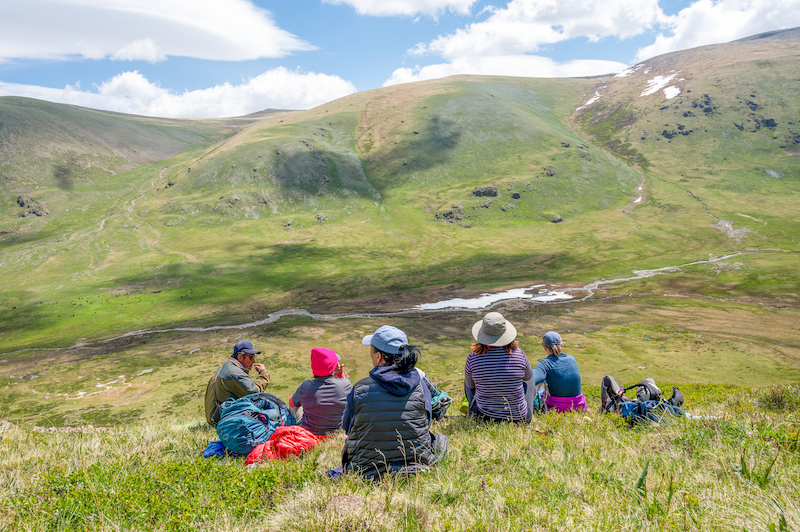
The path meanders a bit farther, through tall grass and over peaks. We pause many times to take in the beautiful views.
The vistas just keep getting better, until we come to what I would consider the best view of all: a downhill stream with a small waterfall hugged by vibrant green grass with a backdrop of snow-capped mountains. It’s absolutely gorgeous!

Trekking To A Glacial Lake
After a yummy campsite lunch of rice, veggies, and chicken — and tuna for me — we go for a second hike to a glacial lake.
While this hike is flatter, the challenges come with the river crossings and bushwhacking, the thick undergrowth creating tripwires underfoot.
A salamander crawls out of the mud as an eagle flies over the towering peaks.
There are also stunning wildflowers like purple bird’s-eye primrose, violet meadow clary, yellow sweet yarrow, white mountain avens, and bright orange globe flowers that make the landscape even more epic.
My favorite view comes during one particularly long river crossing, and I stop on a rock to capture it:

Finally, after about two hours — and a bit of hail — we come to what my guide calls “Middle Valley Lake.”
We have arrived, and it feels so good.
After eight miles of Altai Mountain trekking, I feel exhausted but also incredibly thankful to be here.
Hiking up mountains while experiencing four seasons isn’t easy; but it’s rewarding, especially in a place as beautiful as Mongolia’s Altai Mountains, which few tourists visit.
To put this into perspective, only about 66,900 tourists visit Mongolia annually, and only a fraction of those make it to the Altai Mountains Mongolia region. You can compare this to annual tourist visits in other Asian destinations like Thailand (40 million), Indonesia (4 million), and Singapore (3 million).
Back at the “trailhead” — a term I’ll use loosely since the trail isn’t actually on a map — it begins to snow unexpectedly.
But, in reality, Mongolia is best enjoyed without expectations. Though, when visiting the Altai Mountains, there is one thing you can expect: astounding beauty and wild open spaces.

Altai Mountains Mongolia Packing List
Doing a ger homestay in the Altai Mountains requires more packing and planning than staying in a typical hotel.
For instance, along with trekking gear, you’ll need your own hygiene products. This is because there isn’t a formal bathroom with a toilet and sink, but a small shed with a hole in the ground.
A few items I highly recommend adding to your Mongolia packing list include:
- Toilet paper
- Biodegradable cleansing wipes
- Hand sanitizer
- Water bottle or hydration bladder
- Portable water filter
- Chapstick with SPF
- Polarized sunglasses
- Sunscreen
- Sleeping pad
- Sleeping bag
- Sleeping liner
- Down jacket
- Rain jacket
- Rain pants
- Daypack with waterproof cover
- Hiking snacks
- Moisture-wicking base layer for hiking
- Hiking boots with Gore-Tex
- Moisture-wicking socks
- Sock liners
- Moleskine adhesive to prevent blisters
- Gifts for your host family (optional, but appreciated)
- Portable charger since there aren’t outlets
- Travel insurance — essential to make sure you’re always protected
This is on top of your regular clothing, medications, chargers, camera, extra camera battery, and other items you may want to pack.
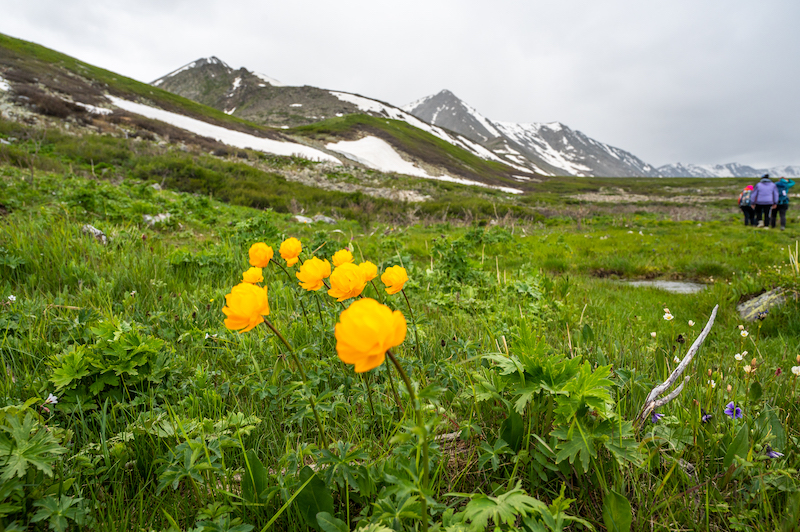
Mongolia Travel Discount
As mentioned above, I went to Mongolia with WHOA Travel and loved the experience! Get $100 off any WHOA trip around the world with code JESSIEONAJOURNEY.
Mongolian Altai Mountains FAQ
Here are answers to frequently asked questions about the Altai Mountains in Mongolia:
Q) Where are the Altai Mountains?
The Altai Mountain Range is located in Central and East Asia. It spans multiple countries including Russia, Kazakhstan, Mongolia, and China.
Q) What are some interesting Altai Mountains facts?
The Altai Mountains are estimated to be around 300 to 500 million years old, making them one of the oldest mountain ranges on Earth.
Additionally, the Altai Mountains are adorned with ancient rock art and petroglyphs dating back thousands of years, providing insights into the ancient cultures and beliefs of the region.
Q) What is special about the Altai Mountains?
The Altai Mountains are known for their stunning natural landscapes, including towering peaks, deep valleys, alpine meadows, glacial lakes, and diverse plant and animal life.
Additionally, they hold great cultural significance and have been inhabited by various Indigenous communities for thousands of years, including the Altai people, Kazakhs, Mongolians, and others.
Q) Why should someone visit Mongolia’s Altai Mountains?
A few of the main reasons to visit the Altai Mountains in Mongolia include stunning natural beauty (particularly in Altai Tavan Bogd National Park), rich biodiversity, and outdoor activities like hiking, climbing, fishing, and horseback riding. Moreover, there are many opportunities for cultural immersion, such as doing a ger homestay with a Kazakh family.
Q) What is there to see in Altai Tavan Bogd National Park?
The park is named after the “Five Holy Peaks” of Tavan Bogd, which are the highest mountains in Mongolia and can be explored here. Additionally, you can visit Potanin Glacier (the largest glacier in Mongolia), see the stunning Khoton, Khurgan, and Dayan Lakes, view ancient rock art and petroglyphs, and spot wildlife like snow leopard, Altai argali (a type of wild sheep), ibex, and Siberian ibex.
Q) What does “Altai” mean?
The word “Altai” itself is of Turkic origin and is derived from the Mongolian word “altan” or “altanii,” meaning “golden” or “golden mountains.” This name is fitting due to the stunning natural beauty and rich mineral resources found in the Altai Mountains.
Q) What is the best time to visit the Altai Mountains?
The best time to visit Mongolia differs depending on where exactly you’re going. When it comes to the Altai Mountains, the ideal time to visit is during summer (June to August) for warm weather and vibrant landscapes or the shoulder months of late spring and early autumn for fewer tourists and pleasant conditions. Winter offers a unique, snowy experience but is considerably colder, and early spring can be unpredictable.
Have you visited the Altai Mountains in Mongolia?
Enjoyed this Altai Mountains Mongolia guide? Pin it for later!
Jessica Festa
Latest posts by Jessica Festa (see all)
- A Culturally-Immersive Adventure In Mongolia’s Altai Mountains - Jul 8, 2023
- This Recipe Sharing Platform Supports Women In The Culinary Industry (Labneh Recipe Included!) - Nov 5, 2020
- Hiking The Mohare Danda Community Eco-Trek In Nepal - Jun 3, 2020
- 6 Important Questions For Choosing A Responsible Yoga Retreat - May 18, 2020
- How To Create & Grow A Profitable Blogging Business (Ethically) - Jan 18, 2020

